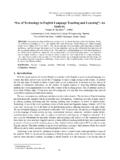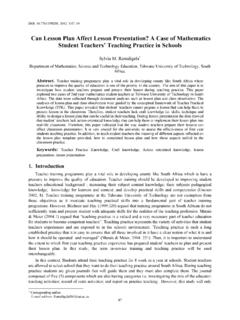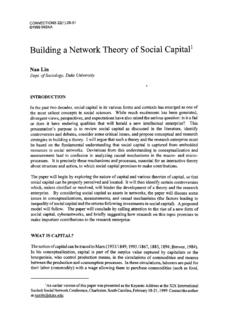Transcription of Enhancing the innovation capability in the …
1 Enhancing the innovation capability in the organization: A conceptual framework Zeinolabedin Rahmani 1 +, Seyed Ali Mousavi 2 1 Assistant professor & chairman of the department of economic & management in PNU Mazandaran, Iran 2 Student of MBA in PNU, Tehran, Iran Abstract. The purpose of this paper is to contribute to the existing knowledge in the field of innovation by exploring two important antecedents of social capital which may contribute to make an increase in the level of absorptive capacity and innovation outcomes of absorptive capacity including innovation capabilities.
2 These antecedents are organizational context and managerial behavior. A conceptual framework synthesized from a review of the literature is offered. With the help of the proposed model not only the links between variables can be viewed graphically but also organizations will learn that how they can improve their absorptive capacity and innovation activities through high level of social capital . Keywords: social capital ; absorptive capacity; organizational context; managerial behaviour; innovation . 1. Introduction social capital is a unique resource, it cannot be traded on an open market and it cannot be easily exchanged from one organization to another [32].
3 These features make of social capital a potential source of firm competitive advantage and can help explain the differential success of firms in competitive rivalry [35]. The internal social capital of organizations, generally defined as a resource reflecting the character of social relations within the firm has proved to be a powerful factor explaining several organizational concerns, such as intellectual capital creation, solidarity benefits, higher levels of trust, or firm performance. Organizational context which can be defined as the set of administrative and social mechanisms of influence arise as a key organizational attribute to facilitate the creation of internal social capital in the firm.
4 On the other hand, Pastoriza et al., (2007) argues that a managerial behavior based on the true concern for the wellbeing of employees and their personal development can be particularly important for the generation of internal social capital [11]. At the same time, it is widely accepted that critical knowledge is not always easily available through external sources [27], which fosters a need for creating knowledge internally [17]. However, with respect to both modes of knowledge sourcing, the capacity to absorb knowledge has become crucial, too.
5 Absorptive capacity is seen as an explanation of competitive advantage [65], innovation [14], and firm performance [31]. In addition, According to Barney (1991), there are many ways that can be undertaken by the company to achieve competitive advantage; however, the most important aspect required in a dynamic environment is success in generating innovation [20]. Therefore, innovation is a key factor for a company to survive and grow on the long run. So firms in the context of firm competitiveness, should consider innovation as an attempt to create competitive advantage by perceiving or discovering new and better ways of competing in an industry and bringing them to the market.
6 Therefore, we decide to provide a conceptual framework which proposes relationship between social capital plus its antecedents and absorbtive capacity plus it s innovation outcomes. Theoretical explanations and empirical evidence are presented to substantiate the relationships between the constructs used in the framework. We begin by reviewing the literature that + Corresponding author. Tel.: + 981513210577; fax: + 981513258960. E-mail address: 2852011 2nd International Conference on Education and Management Technology IPEDR (2011) (2011)IACSIT Press, Singapore elaborates on the nahapiet & Ghoshal s (1998) dimensions of internal social capital including structural, relational and cognitive.
7 Then we draw upon two important antecedents of internal social capital which have an impact on creation of it including organizational context and supportive managerial behavior. Then, we adopted Zahra and George s (2002), four dimensions of knowledge acquisition, assimilation, transformation, and exploitation in our framework for absorptive capacity. Finally, innovation capability part is developed according to the concepts of reference [43] which defined innovation capability as the performance of the enterprise going through various types of innovation to achieve an overall improvement of its innovation capability .
8 Several propositions are derived from the discussion. The final section concludes by implying some managerial implications and directions for future research. 2. Review and framework social capital The contribution of social capital to innovation is achieved by reducing transaction costs between firms and between firms and other actors, notably search and information costs, bargaining and decision costs, policing and enforcement costs [33]. Therefore, the overall hypothesis of the social capital theory in the matter of innovation is that: Firms in communities with a large stock of social capital always have a competitive advantage to the extent that social capital help reduce malfeasance, induce reliable information to be volunteered, cause agreements to be honored, enable employees to share tacit information, and place negotiators on the same wave-length.
9 This advantage gets even bigger when the process of globalization deepens the division of labor and thus augments the needs for co-ordination between and among firms. [33]. The following definition encompasses this view and is used in this study to define social capital . For researchers, the term is popular partly due to the broad range of outcomes it can explain [14], the multiplicity of uses for social capital has led to a multiplicity of definitions. social capital is: .. the sum of the actual and potential resources embedded within, available through, and derived from the network of relationships possessed by an individual or social unit [24].
10 The link between social capital and a firm s competitive position is receiving increased attention. Building on applications of social capital at the individual, group, and societal level, more recent work has considered social capital as an organizational-level resource [13],[ 24]. Researchers have differentiated between internal social capital that examines the closure or bonding that creates internal cohesiveness and external social capital that examines brokerage or bridging linkages to external groups [39], [37].
















